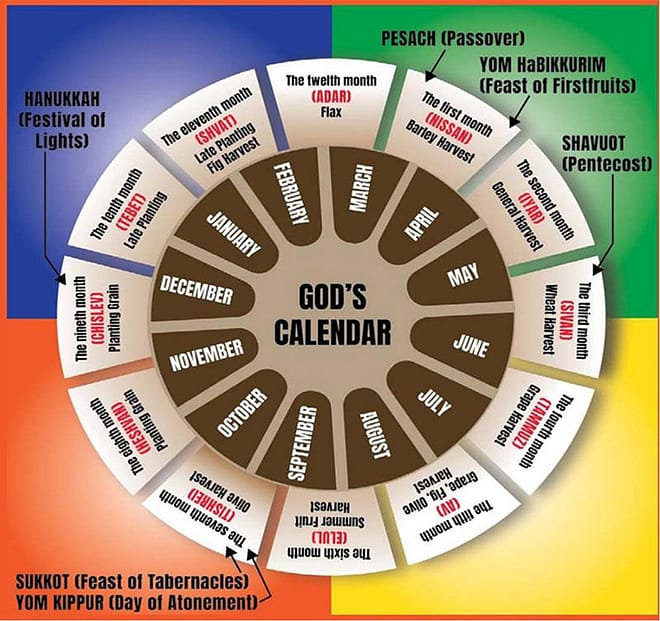What then, is this authorized calendar?
We know from the bible when a day begins – sunset! We know when the week begins – ie sunset at the end of the Sabbath in Jerusalem. Other vital information has not been given to us – only to those who were authorised to proclaim the calendar. So, when is the start of a month?
Exodus 12:1-3 And the LORD spake unto Moses and Aaron in the land of Egypt, saying, This month shall be unto you the beginning of months: it shall be the first month of the year to you. Speak ye unto all the congregation of Israel, saying, In the tenth day of this month they shall take to them every man a lamb, according to the house of their fathers, a lamb for a house:
The Hebrew word translated here as month is “chodesh” which means month, not moon, although very occasionally it is translated as moon. The Hebrew expression “Rosh Chodesh” (translated here as beginning of the month), means Head of the Month, not a new moon as we know it. None of this tells us what the head of the month means.
- Is it when the old moon disappears?
- Is it when you first see the faint crescent of the moon when it first becomes visible?
- Is it the lunar conjunction? What’s that? You have the sun and earth lined up and once a month the moon crosses that line. That is a lunar conjunction. This occurs in the period when the moon cannot be seen for up to three days. So is that the biblical head of the month?
- What if the new month occurs in the daytime. Is that day the first of the month or do you declare it for the next day? – particularly at Trumpets.
- Is the new month determined by observation or calculation?
The bible does not clearly tell us the answers. So what does the bible CLEARLY tell us? God tells us – that He gave the work of proclaiming the new months to His constituted authority in the Hebrew nation. THERE IS NO OTHER AUTHORITY. People’s opinions do not count!
The Hebrew judiciary continued to do their job of proclaiming the Calendar New Moons and the beginning of the years down through the ages. They did it through captivity; through restoration with Ezra; through turmoil under the Persians and Greeks! Then we come to the time of Jesus Christ when Judah was a province of Rome.
At this point we find the Sanhedrin being the official judiciary body of Judah. It was composed of Pharisees, who were mostly laypeople. And also Sadducees, who were deemed to be the priesthood and controlled the Temple services, including the proclamation of the festivals – and ripping people off with Temple taxes. These two bodies set up by God, through Moses, were still functioning in one way or another. But the question is: could these sometimes corrupt people be trusted with God’s authorised calendar, and proclaim the new moons and festivals on the correct days?
The gospels tell us that Jesus Christ died for each one of us on the same Passover as proclaimed by these same Jewish authorities. And on one of the greatest events ever to take place in human history, when the Holy Spirit was given to man by Jesus Christ AND the Father in Heaven, it was the same Pentecost as proclaimed by the Jewish authorities – who had kept the calendar faithfully down to that time from the time of Moses.
You could NEVER get a greater endorsement of the accuracy of the Hebrew Authorised calendar than this! Endorsed by the Father in Heaven with Jesus Christ at His side. Endorsed by the outpouring of God’s Holy Spirit on HIS converted people.
And before that time – AND since that time, there has NEVER been another group who has been given authority by God to over-ride the role that the Priesthood and the Jewish judiciary held in this matter of declaring the Holyday Calendar. Their authority in this matter was approved by Christ Himself. So what has happened since then?
God’s authorized calendar preserved through challenging times
There was a seat of advanced Jewish scholarship in a place called Jabneh, in Galilee. In about 68AD, during the first Jewish rebellion against Rome, Jabneh obtained special permission from the Roman General Vespasian, that Jabneh and its Jewish scholars be spared in the warfare with Rome.
When the Sanhedrin fled the destruction of Jerusalem, two years later in 70AD, they joined up with these scholars in Jabneh. From that place, they continued to proclaim the calendar, so that ALL Jewish communities around the world had the means to keep the festivals and worship God together, at the same time. Quoting from Jewish History: In some respects, the city was now regarded as the equal of Jerusalem: there the year was intercalated (proper adjustments were made to the calendar) and the shofar blown, and pilgrims from Asia visited the city three times a year (Tosef., Ḥul. 3:10; RH 29b; Shab. 11a).
So life went on! This Sanhedrin in exile often endured much persecution over the next three hundred years from pagan Rome.
The early Church was resilient too!
What did the Church do after its formation in 31AD? The New Testament shows that Paul kept the same Holy Days as were proclaimed by the Jewish authorities. And history shows that true Christians also observed the same days as the Jews – and were persecuted along with them. Polycarp, who was a follower of the apostle John, was still keeping them about 155AD.
But Roman persecution against the Jews intensified. In 313AD, Synagogues were outlawed. In 341AD, Passover was outlawed. The Sanhedrin itself was targeted.
The last major decision the Sanhedrin made before being disbanded, was to release the details of the calendar calculations to the Jews around the world, so that they could come before God and worship Him as a unified body – without the need of official proclamations! This was a masterstroke! God’s Authorised calendar would be preserved by scholars throughout the whole Jewish community! The calendar calculations were released in 358AD.
THIS calendar is the one that has come down to us today – because the Jews have preserved it and have used those calculations ever since.
PART 4 crowns it up!




This is so outstanding and very enlightening.